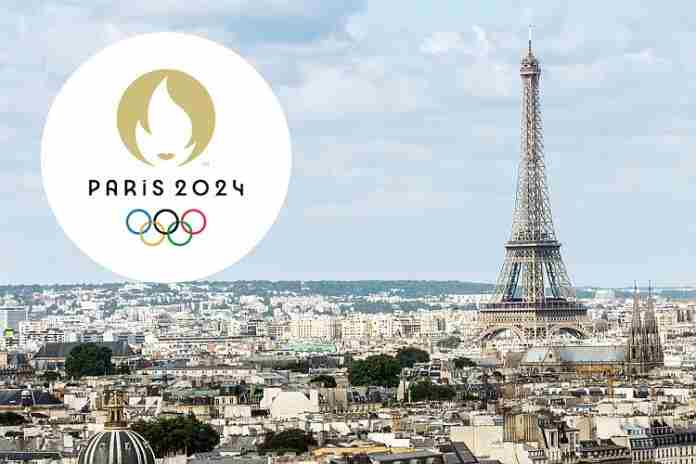★ The Sports Examiner: Chronicling the key competitive, economic and political forces shaping elite sport and the Olympic Movement.★
★ To get The Sports Examiner by e-mail: sign up here! ★
● HAPPY NEW YEAR! ●
≡ THE 5-RING CIRCUS ≡
In a difficult, troubled year, a lot of turmoil marked the top stories in Olympic sport during 2023; our top five:
5. Crouser, Lyles and Kipyegon lead a great year in T&F
4. French Alps, Salt Lake and Swiss (?) get Winter Games
3. LA28 expands to largest Games ever with 36 sports
2. Victoria’s Commonwealth Games withdrawal a true shocker
1. Russia, security and Tahiti dominate Paris 2024 build-up
● Panorama: International Olympic Committee (New Year’s message from President Bach) = Russia (Law passed to allow payment of foreign athletes to compete in Russia) = Spain (Prosecutors inquiring into possible testing issues by Spain’s anti-doping unit) = Alpine Skiing (2: Shiffrin takes 92nd win at Lienz; Sarrazin surprises in Bormio downhill) = Athletics (USATF membership totals up for 2023) ●
LANE ONE:
The top stories of 2023, from no. 5 to no. 1
It would be nice if the top stories of 2023 were about athlete achievement on the field of play. Instead, it was a year of war, politics, anger, broken promises and more, with some sparkling sporting events thrown in (you can see nos. 10 to 6 here):
No. 5:
Crouser, Lyles and Kipyegon lead a great year in T&F
There were lots of bad things that happened in the world and in sport in 2023, but the year in track and field was mostly great, including a long list of world records (and world bests):
Men:
● 2,000 m: 4:43.13, Jakob Ingebrigtsen (NOR)
● Two Mile: 7:54.10, Ingebrigtsen
● Steeple: 7:52.11, Lamecha Girma (ETH)
● Marathon: 2:00:35, Kelvin Kiptum (KEN)
● Vault: 6.22 mi (20-4 3/4i), Mondo Duplantis (SWE)
● Vault: 6.23 m (20-5 1/4), Duplantis
● Shot: 23.38 mi (76-8 1/2i), Ryan Crouser (USA)
● Shot: 23.56 m (77-3 3/4), Crouser
Women:
● 1,500 m: 3:49.11, Faith Kipyegon (KEN)
● Mile: 4:07.64, Kipyegon
● 5,000 m: 14:05.20, Kipyegon
● 5,000 m: 14:00.21, Gudaf Tsegay (ETH)
● Marathon: 2:11:53, Tigist Assefa (ETH)
● 35 km Walk: 2:37:44, Kimberly Garcia (PER)
● 35 km Walk: 2:37:15, Maria Perez (ESP)
● Mixed 4×400 m: 3:08.80, United States
World Athletics also recognized, for the first time, world marks in the road mile, with American Hobbs Kessler taking the men’s record at 3:56.13 and Nikki Hiltz of the U.S. getting the first women’s mark at 4:27.97, which was broken by Ethiopia’s Diribe Welteji (ETH) at 4:20.98 at the inaugural World Road Running Championships – another good innovation – in Latvia in October.
Crouser’s 23.38 m indoor mark (76-8 1/2i) was not ratified due to the slope of the landing area, a decision he objected to, but then made moot by exploding at UCLA’s Drake Stadium in May with a brilliant 23.56 m (77-3 3/4) performance that wasn’t ratified until November, after a survey was done of the facility!
The World Athletics Championships was held in new facility in Budapest (HUN), with near-capacity crowds of 30,000+ for most sessions and spectacular competition on the field. American sprint star Noah Lyles surprised with a win in the 100 m, then defended his 200 m title and anchored the winning U.S. 4×100 m relay for three golds and lots more attention for 2024. Crouser scared his May world record with a win at 23.51 m (77-1 3/4) and Duplantis won his third straight Worlds vault gold.
American Sha’Carri Richardson realized her enormous potential with a shock win in the women’s 100 m (10.65) over favored Jamaican Shericka Jackson, but Jackson came back to defend her 200 m title (with Richardson third). And Richardson got a third medal with an anchor leg on the 4×100 m relay.
Kipyegon won both the women’s 1,500 m and 5,000 m, and the women’s vault ended with a tie between Australia’s Nina Kennedy and Olympic champ Katie Moon of the U.S. And with world-record holder Sydney McLaughlin-Levrone not competing, Dutch hurdler Femke Bol won the 400 m hurdles in 51.70, the no. 8 performance in history.
This was one of the best seasons in history and set up an even better 2024 and beyond. Look for a sub-14 minute 5,000 m this coming year, and after Kipyegon’s performance in the mile, are we that far away from a woman running under four minutes?
No. 4:
French Alps, Salt Lake and Swiss (?) get Winter Games
The International Olympic Committee had been dragging its feet on figuring out what to do about hosts for the 2030 Winter Games, but solved its issues – apparently – at the end of November with the decision to “target” the French Alps bid for 2030 and to essentially award the 2034 event to Salt Lake City, Utah.
The assignments for 2030-34 won’t be final until a vote in the middle of 2024, but the expectation is that both will be approved. The bid process for 2030 was dragged out by IOC concerns over whether natural-snow conditions could be found for future sites, the strong preference of the ready-to-go Salt Lake City bid for 2034 and the collapse of the Sapporo (JPN) bid due to rising costs and the emergence of multiple scandals in the organization of the Tokyo 2020 Games.
With the IOC’s encouragement, bids from 2030 were developed in Sweden, Switzerland and for the French Alps, with a partnership of the Auvergne-Rhone-Alpes (AURA) and Provence Alpes-Cote d’Azur (PACA) regions. The French came in late, but were rewarded for having most of their facilities already set, but with some holes, and a ready organizing committee-in-waiting in the existing Paris 2024 staff.
The Salt Lake City is truly solid, with no added venues needed and the sites from the successful 2002 Winter Games still in active use. The wait for 2034 will aid its domestic sponsorship efforts, separated from the Los Angeles sales efforts for the 2028 Olympic Games.
Amid talk of a rotation or even a disassembly of the Winter Games, with events in multiple nations, the IOC surprised with a designation of the Swiss bid for “preferred dialogue” – a new category – for 2038. Most of the venues needed for a Winter Games are available in the Swiss plan, but it is too de-centralized for the IOC’s taste at the moment. The designation essentially gives the IOC and the Swiss until 2027 to work out a plan and go ahead with an award for 2038.
The IOC has stability and time to consider what to do about the Winter Games amid its climate concerns. The only loser was Sweden, which once again failed – for the ninth time – to host a Winter Games.
No. 3:
LA28 expands to largest Games ever with 36 sports
Tremendous anticipation and chatter around whether the Los Angeles 2028 organizers would include cricket as an added sport, with the potential of a television-rights windfall in India which could bring LA28 some added cash in a shared deal with the IOC.
But the reality was even stranger, with LA28 asking for five sports to be approved at the IOC Session in Mumbai, India in October: baseball and softball, cricket, flag football, lacrosse and squash!
The IOC approved them all and with the add-back – by the IOC – of a better-behaved weightlifting federation and a revised modern pentathlon, the total number of sports for 2028 will set an Olympic record of 35. At present, there is no federation for boxing, with the International Boxing Association dismissed in June and the new World Boxing group still in formation, but it is more than likely that boxing will be brought in also, to raise the total to 36.
And these new sports will add at least 742 more athletes to the program, blowing past the 10,500 limit suggested in the Olympic Charter. There was also a tantalizing mention that some or all of these added sports could be held outside of the Los Angeles area. Baseball at Yankee Stadium in New York? Softball at its national center in Oklahoma City? Lacrosse at an eastern venue, where it is more popular?
It’s a huge expansion of the Games program, contrary to the reductions brought on during the Thomas Bach presidency at the IOC, but in a sports-loving host country with endless facilities, the possibilities are enticing.
What about flag football, strongly supported by the National Football League, with significant sponsorship implications? With football (soccer) continuing to grow in popularity – significantly among women – flag is a crucial initiative for the NFL to super-charge its growth among women as players, not just as spectators of tackle football.
The LA28 organizers have been quiet about their plans, but have a clear concept that these added sports can expand interest in the Games, now only in 2028 but for the future as well. But make no mistake, the long-term impact of cricket could be enormous.
No. 2:
Victoria’s Commonwealth Games withdrawal a true shocker
Contracts mean nothing. That was one of the major lessons of 2023, with 18 July a key date which be remembered as a pivot point in sports history.
That’s when then-Victoria Premier Daniel Andrews called a news conference to say that after signing an agreement with the Commonwealth Games Federation to host the 2026 Commonwealth Games in April 2022, the state was withdrawing in 2023.
Why? Money. Andrews said that the government’s estimates of the actual cost of hosting the Games on a regional basis – and not primarily in Melbourne – could be A$6-7 billion, instead of the A$2.6 billion projected (A$1 = $0.68 U.S. today). That, he said, could not be justified.
Victoria had to pay A$380 million as a settlement for the withdrawal, a lot less than the amount Andrews feared if the state had to go through with the hosting. As of now, the 2026 Commonwealth Games has no home, with the state of Queensland rejecting another Gold Coast hosting (it hosted in 2018) and no other offer to stage the event, in Australia or elsewhere.
After a long and happy history beginning in 1930, the future of the Commonwealth Games is very much in doubt.
But that was not the only event which was turned upside down in 2023. A much smaller event, the ANOC World Beach Games, expected to be held in August in Bali (INA), was canceled when Bali governor Wayan Koster – playing to pro-Palestinian political feelings in Indonesia – announced and maintained under pressure that Israeli qualifiers would not be allowed to compete at the event (this was more than three months before the Hamas invasion of Israel).
The Association of National Olympic Committees (ANOC), which owns the event, protested, but Koster persisted and the event was canceled on 5 July – two weeks before Victoria pulled out of the Commonwealth Games – on the excuse that the Indonesian government had not released funds needed for the event. No one believed that lie; it was anti-Semitism, pure and simple. And ANOC would not stand for it, with 1,500 athletes losing out; ANOC later reimbursed all of the participating National Olympic Committees for their travel costs.
Indonesia had already had another event removed for its anti-Israel policy, as the FIFA men’s U-20 World Cup – scheduled for May – was rescinded by FIFA on 29 March because of its refusal to host the Israeli team, also scheduled to play in Bali. The tournament was moved to Argentina and held as scheduled, with the Israelis winning the bronze medal.
FIFA was apparently not that upset with Indonesia, however, as it awarded it the FIFA men’s U-17 World Cup, played in November, after Peru pulled out as host.
Of course, the ANOC and FIFA agreements had non-discrimination clauses in them, but that didn’t matter to Indonesia. In 2023, in fact, contracts did not matter.
No. 1:
Russia, security and Tahiti dominate Paris 2024 build-up
There were grave concerns coming into 2023 about the ability of the Paris 2024 organizers to maintain a balanced budget and for the government’s Solideo construction agency to complete the Olympic housing and sports venues projects in time and on budget.
Both of those worries have dissipated, as Paris 2024 has just about reached its sponsorship targets and has sold 7.6 million Olympic tickets, with another million to be placed on sale in 2024. Solideo reported that it will turn over the sites it is responsible for on time.
Instead, new issues dominated the headlines, starting with Russian and Belarusian participation. Essentially banned due to an IOC edict since the Russian invasion of Ukraine began in February of 2022, IOC chief Bach engineered – citing the symbolic impact of “universal participation” in the Olympic Games – a protocol in March to have international federations allow participation in their events of individual Russian and Belausian “neutrals” who have “not supported” the war against Ukraine.
Most of the federations bought in, albeit at inconsistent levels of enthusiasm, with some only allowing participation in 2024, such as in aquatics and gymnastics. World Athletics and the International Surfing Association said no, and the Federation Equestre Internationale said it would allow participation in 2024, but not in the Paris 2024 Olympic Games, since the qualifying period has ended.
Multiple European governments protested, but the Paris 2024 organizers and French President Emmanuel Macron said the decision is up to the IOC. Ukraine has threatened a boycott, but no firm decision has been made as yet. The Russians, for their part, have savagely criticized Bach and the IOC as tools of the West and specifically of the U.S., but without any significant impact.
The IOC’s own protocol for Russian and Belarusian participation in Paris was released in early December. Bach is intransigent on this point: there will be Russians and Belarusians in Paris, but not many.
There were other issues for Paris 2024, including worries about security, especially of holding the Games opening as a parade on the Seine River in the middle of Paris, witnessed by 100,000 ticket holders on the river-side level and several hundred thousand more on the upper levels. No confirmation is exactly how many people will be able to attend has been made, with concerns over the capacity of the area, capacity of the transport system and the available of enough private and public security, police and military to handle the crowds and potential troublemakers.
The 7 October Hamas attack on Israel and the response has heightened fears of terrorism, especially at the opening.
A test event in open-water swimming had to be canceled due to poor water quality in the Seine following heavy rains, but a triathlon test event was held under better weather and was satisfactory.
Police officials have been in the spotlight, with questions about staffing, training and a plan – for security reasons – to remove some of the famous book stalls that line the Seine for the opening. A plan to restrict transit and require passes (a QR code) for residents to access areas around some of the venues in Paris has been criticized on civil liberties grounds. And politicians of opposing parties have been criticizing each other over failures to complete promised transit works or resolve homelessness issues in the French capital.
So what else is new?
The year ended with a compromise on the building of a new judging tower in French Polynesia (Tahiti) for the surfing events. A planned new tower of 46 feet in height raised an emotional backlash about damage to the local coral at the famed Teahupo’o site, with petitions circulated to remove the event from Tahiti altogether. But discussions produced a solution, essentially to rebuild the old and unsafe wooden judging tower with a new, aluminum structure that will keep impact to the environment to a minimum.
The Paris 2024 organizers achieved a lot in 2023 and are poised for a considerable success in 2024. But as dependable as the sunrise is the steady stream of angst, complaints and back-biting that will continue through the closing ceremony of the Paralympic Games next September.
≡ PANORAMA ≡
● International Olympic Committee ● President Thomas Bach (GER) offered his New Year’s message on Thursday, extolling the virtues of the Olympic Games as a symbol of hope:
“Deep in our hearts, we are all longing for something unifying. Something that brings us together, despite the differences we have. Something that gives us hope. Something that inspires us to address problems in a peaceful way. Something that brings out the best in us. We are longing for the Olympic Games Paris 2024 to unite the entire world in peaceful competition.”
And he sounded again the watchwords of his term and his vision of the Olympic Games, now and in the future:
“With the Olympic and Paralympic Games Paris 2024 only months away, the athletes, the fans, the entire Olympic community – all of us – are looking forward to a new era of Olympic Games: younger, more inclusive, more urban, more sustainable.”
● Russia ● How will the Russian Sports Ministry attract foreign athletes to compete in its BRICS Games next June and the World Friendship Games next September?
Pay them.
The Russian news agency TASS reported on Monday:
“Russian President Vladimir Putin signed a law that, among other things, gives the Russian Olympic and Paralympic Committees (ROC and RPC) the authority to finance the participation of foreign athletes in competitions in the Russian Federation. …
“In particular, the ROC, RPC, the Russian Deaflympic Committee and the Special Olympics of Russia are given the right ‘to provide financial support for the participation of foreign citizens and stateless persons as athletes and (or) teams of foreign citizens in official sporting events on the territory of the Russian Federation and abroad.’”
Just for information, the current exchange rate for the Russian ruble to the U.S. dollar is 88.75:1.
● Spain ● A story on the Spanish sports site Relevo reported that the Spanish anti-doping agency (CELAD) carried out sample collection with a single company and did not use a second collection officer from a different company as apparently required, from 2017-22. This procedure could allow for cover-ups of doping-positive samples, or for nullification of tests since the multi-agent process for collection was not used.
The matter is now under investigation by Spanish government authorities, as CELAD is at least partially publicly funded.
● Alpine Skiing ● She did it again! U.S. superstar Mikaela Shiffrin won her 92nd career World Cup race on Thursday, taking the women’s Giant Slalom in Lienz (AUT) with a dominating first run.
Shiffrin, the overall World Cup leader, flew down the course as the no. 3 starter and took the lead at 1:01.82, with Swede Sara Hector well back at 1:02.45 in second place.
Italy’s 2022 Olympic runner-up Federica Brignone moved from fifth into the lead on the second run in 1:02.91, to give her a total of 2:06.36. Although Shiffrin’s second run of 1:04.16 ranked only 17th, it was still enough for a comfortable total of 2:05.98, and a win by 0.38 over Brignone.
Hector finished third with a two-race total at 2:06.43, with Americans A.J. Hurt in 11th at 2:07l81 and Paula Moltzan in 16th at 2:08.21.
The win was Shiffrin’s fourth of the season, and her eighth medal out of 13 World Cup races held so far. Brignone now has six medals this season (3-1-2). The women will be back on the slopes on Friday for a Slalom in Lienz before the New Year’s break.
¶
Good news and bad news on the famed Stelvio downhill course in Bormio (ITA) on Thursday, with France’s Cyprien Sarrazin, now 29, winning his first World Cup race since December of 2016!
Sarrazin hadn’t won a World Cup medal since December of 2019, but his winning run came from fourth in the order, and held up against reigning World Cup champ Marco Odermatt (SUI) in the no. 6 slot, 1:50.73 to 1:50.82. Canada’s Cameron Alexander, starting fifth, ended up with the bronze (1:51.96), his second career World Cup medal.
The bad news came from the 17th starter, overall World Cup leader Marco Schwarz (AUT), skied over a bump in the course halfway down and suffered a season-ending right knee injury. He had to be flown off the course in a helicopter and received treatment in Innsbruck (AUT), about 130 miles away.
Odermatt resumed the seasonal lead and won his fourth medal in nine World Cup races held so far. A Super-G will be held on Friday.
● Athletics ● USA Track & Field reported improved membership numbers at its annual meeting in December, with 115,444 total members in 2023, ahead of the 2022 total of 104,958, but still short of the pre-pandemic total of 123,833 from 2019.
Adult members grew considerably from 39,621 to 73,004, well ahead of the 2019 total of 45,989, but youth memberships were way down. That total was 77,840 in 2019, 65,337 in 2022 and just 42,440 in 2023.
For comparison, USA Swimming’s last report was for 2021, with 331,228 members; USA Gymnastics has approximately 200,000 members.
¶
You can receive our exclusive TSX Report by e-mail by clicking here. You can also refer a friend by clicking here, and can donate here to keep this site going.
For our updated, 850-event International Sports Calendar (no. 4) for 2023 and beyond, by date and by sport, click here!
















